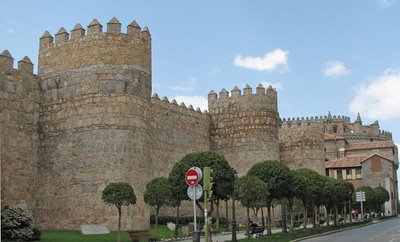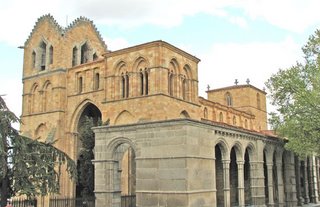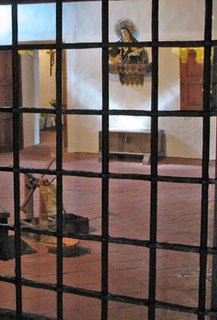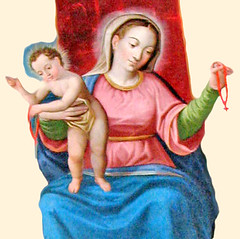Avila (Part One)
 Saint Teresa of Jesus, that great Carmelite reformer and founder of the Discalced branch of that Order, the mystic and spiritual teacher and Doctor of the Church, has shed the light of her fame and glory upon the city of Avila which was both her birthplace and home and the city from which her reforms began. People throng to Avila mainly to visit the sites associated with her, but even if she had not touched the city with her presence, it would still be well worth a visit because it remains an amazing medieval Spanish fortified city with a fortress-like cathedral and a historically significant Dominican priory.
Saint Teresa of Jesus, that great Carmelite reformer and founder of the Discalced branch of that Order, the mystic and spiritual teacher and Doctor of the Church, has shed the light of her fame and glory upon the city of Avila which was both her birthplace and home and the city from which her reforms began. People throng to Avila mainly to visit the sites associated with her, but even if she had not touched the city with her presence, it would still be well worth a visit because it remains an amazing medieval Spanish fortified city with a fortress-like cathedral and a historically significant Dominican priory. The photo above shows the walls of Avila which are the second longest in the world. They completely encircle the city which is perched on a rocky plateau above the dry plains of Old Castille and the view from the train as we approached was breathtaking! On the left is a photo of the main gate that pierces the wall.
The photo above shows the walls of Avila which are the second longest in the world. They completely encircle the city which is perched on a rocky plateau above the dry plains of Old Castille and the view from the train as we approached was breathtaking! On the left is a photo of the main gate that pierces the wall.
Such fortification was necessary in the 12th century when Avila was captured from the Moors as part of the Christian re-conquest of the Iberian peninsula. At that time the whole of the south of Spain was still under Moorish rule and furthermore, during that period there were no borders or consolidated dominions. Hence the fortified city of Avila was on the frontline of defence against Moorish insurgence.
With Avila's fortifications in mind and even the fortress-like cathedral (the facade is shown on the right), one can see how the image of the 'Interior Castle' might have come very naturally to St Teresa.
 St Teresa entered the Carmelite convent of the Encarnacion which actually stands about ten minutes walk from the basilica of St Vincent (shown on the left here), without the walls of Avila. We first made our way to this lovely 12th-century Romanesque church which was built to house the shrine of St Vincent and his two sisters Sabina and Cristeta who were martyred on this site by the Romans. Inside the basilica is a marvellous medieval shrine built to house the body of St Vincent (below right) as well as other shrines to local saints and a shrine to Our Lady in the crypt.
St Teresa entered the Carmelite convent of the Encarnacion which actually stands about ten minutes walk from the basilica of St Vincent (shown on the left here), without the walls of Avila. We first made our way to this lovely 12th-century Romanesque church which was built to house the shrine of St Vincent and his two sisters Sabina and Cristeta who were martyred on this site by the Romans. Inside the basilica is a marvellous medieval shrine built to house the body of St Vincent (below right) as well as other shrines to local saints and a shrine to Our Lady in the crypt.
The presence of this basilica and the witness of these Roman martyrs reminded me of the ancient Christian roots of Spain and that even before St Teresa, Avila was already a home to Christian saints. But everywhere one goes in Spain, there is the presence of the other two great monotheistic faiths which have had such an impact on this country and its culture. For the legend of St Vincent and his martyrdom is linked to a certain Jew and the Moorish influence is seen in the architecture of the church, especially in its campanile and the shape of the south portal (below).
 Having explored this basilica, we looked down from its vantage point and saw the Encarnacion convent in the distance and walked down the hill to it. St Teresa of Jesus entered this Carmelite house on 2 November 1535 when she was just 19. She lived here for 30 years and it was here that she had conferences with St John of the Cross and was prioress for three years from 1571. What follows are photos of the Encarnacion and the museum of St Teresa of Avila which is housed here. Br Paul is a fond devotee of St Teresa so this was an especially special visit for him and we were both surprised to note that this convent itself was only reformed in 1940!
Having explored this basilica, we looked down from its vantage point and saw the Encarnacion convent in the distance and walked down the hill to it. St Teresa of Jesus entered this Carmelite house on 2 November 1535 when she was just 19. She lived here for 30 years and it was here that she had conferences with St John of the Cross and was prioress for three years from 1571. What follows are photos of the Encarnacion and the museum of St Teresa of Avila which is housed here. Br Paul is a fond devotee of St Teresa so this was an especially special visit for him and we were both surprised to note that this convent itself was only reformed in 1940!

 On the left is the large statue of St Teresa that stands in front of the belfry and near the entrance to the convent.
On the left is the large statue of St Teresa that stands in front of the belfry and near the entrance to the convent.On the right is the courtyard in front of the convent which features the seven chambers of the Interior Castle which is central to St Teresa's spiritual writings on the stages of Christian perfection.

In this very chamber shown above, two saints met in holy converse, planning the reform of their Order. A painting of St Teresa and St John of the Cross levitating on the occasion of one such meeting here can be glimpsed on the left wall. There was a palpable sense of sanctity in this room...


On the left above is a glimpse of St Teresa's cell when she was prioress and on the right is the reception hall of the convent where there is a fresco of St Teresa of Jesus. The little nun kneeling behind her is her niece who also entered the Encarnacion after her.


In that same reception room is the fresco on the left above of the Scourging of the Lord. St Teresa instructed a sister nun to draw this on the wall after she had received this vision of Our Lord's suffering. Above right is the unique and famous ink drawing of Our Lord's Crucifixion by St John of the Cross. The full significance of this beautiful little drawing which is housed in the museum of the Encarnacion convent can be explored at this site.
Let us end here for today, contemplating that saint-drawn vision of Our Lord on the Cross...
Still to come: More of Avila including the Dominican convent of Santo Tomas.







0 Comments:
Post a Comment
<< Home